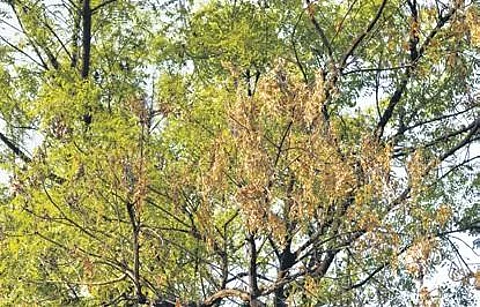

HYDERABAD: This time around, Ugadi pachadi may not have its signature neem sting. With just four days left for Telugu New Year’s Day, the non-availability of neem inflorescence in the twin cities and the rest of the State is dampening the spirit of Telugus.
The neem trees appear devoid of inflorescence because of the twin attacks by a parasite called Loranthus or Honey Suckle Mistletoe and fungal attack which causes dieback disease.
The number of neem trees in the city has come down over the years. Even those that are existing are not bearing the full inflorescence necessary for preparing Ugadi pachadi.
The dieback fungal disease is spreading fast, causing progressive death of twigs and branches. Once the fungus infects the tree, a neem tree begins to dry up and its yield is hit. Ironically, neem trees that
have become synonymous with providing good health to people through their twigs, leaves, flowers, bark, seeds, and fruits have been dying a natural death due to the rare pest. Neem is a natural pesticide and now it has become a victim of the pest that attacks only neem trees.
Neem tree is also known for its medicinal properties and is a vital ingredient in the production of fungicides and insecticides, effective against a wide array of pathogens. But today it is ironically under attack by a fungus. In the severely infected trees, there is a loss of flowers and fruit.
Although the neem tree is affected by several microorganisms, Phomopsis azadirachtae is the most dangerous of all. The disease changes the leaf colour to pale green or yellow, scorches the leaf margins and reduces the growth of twigs and stem.
Experts: Neem trees will rejuvenate on their own
The fungal infection attacks after the stem borer insect leave holes in the branches. High humidity and change in climatic conditions are also blamed for the increase in attacks by the dieback fungus, experts said.
A few months prior to the outbreak of the dieback disease, the neem trees used to be infested by a parasite creeper called Loranthus also known as Honey Suckle Mistletoe. Once it affects, the quantity and yield of flowers go down considerably. Loranthus anchor themselves onto the branches of trees and suck water and nutrients directly from their branches. They cover entire the tree, blocking out sunlight.
The parasite creeps along the stem of the host and attaches with the help of peg-like structures (haustoria) at several places on the host. At the point of attachment, haustoria penetrates into the tissue of the host and absorbs nutrients and water, weakening the host tree.
Urban biodiversity officials said some trees are rejuvenating again on their own after enduring the whiplash of fungal disease as neem trees have the inherent capability to fight back and survive the pest without any external intervention. But the process may take longer, they added.